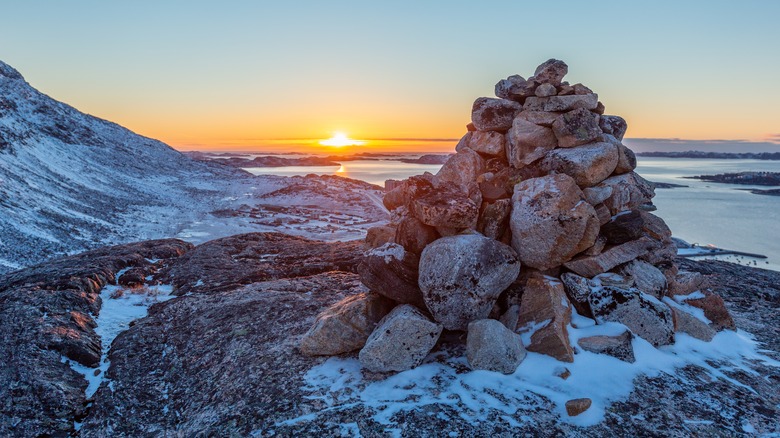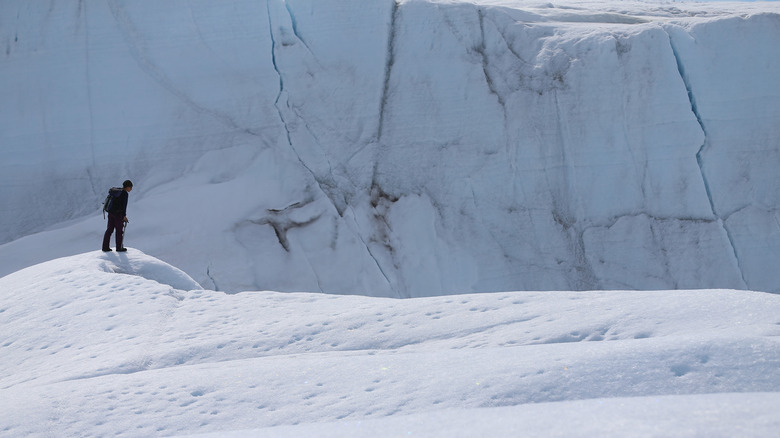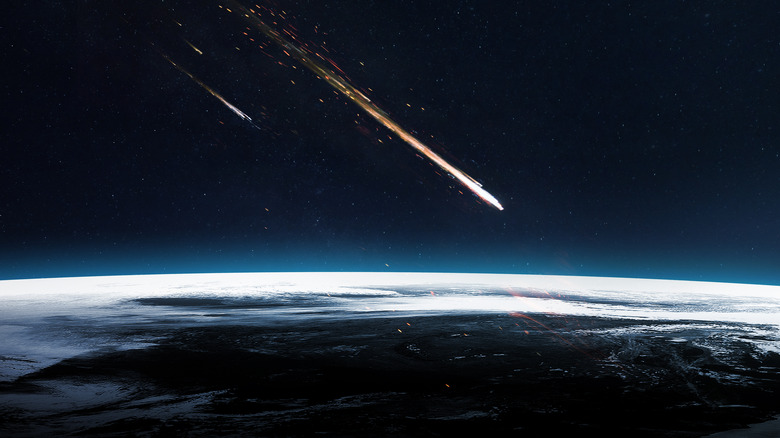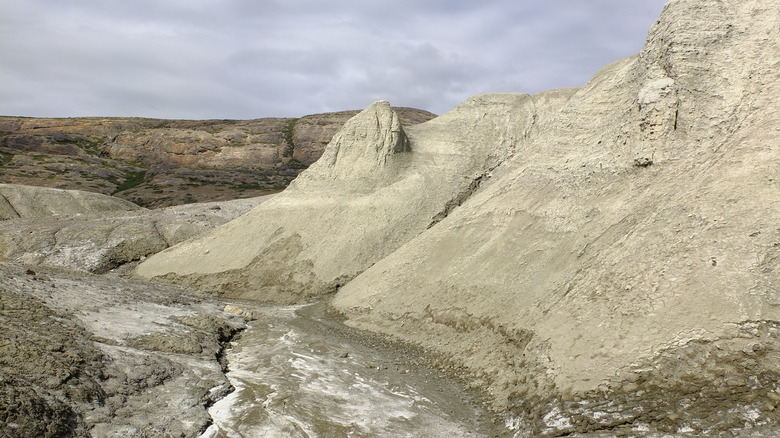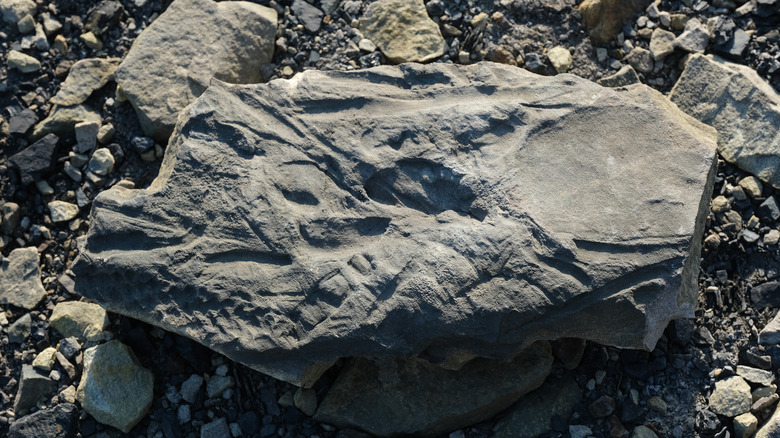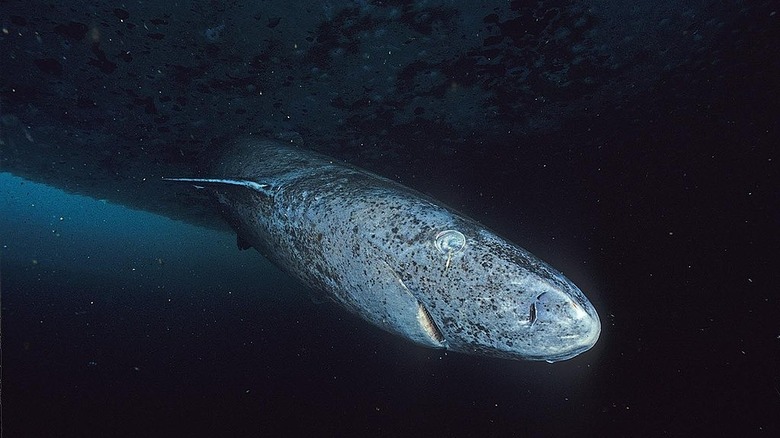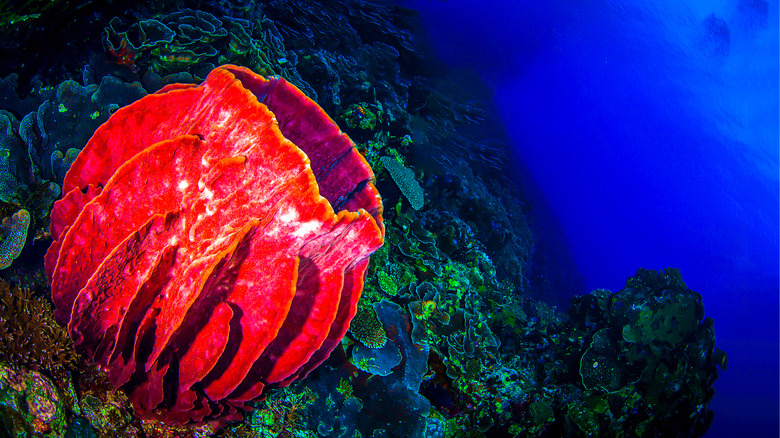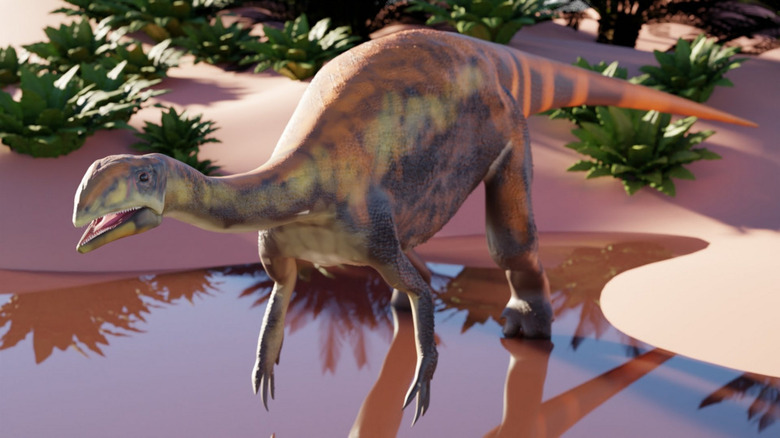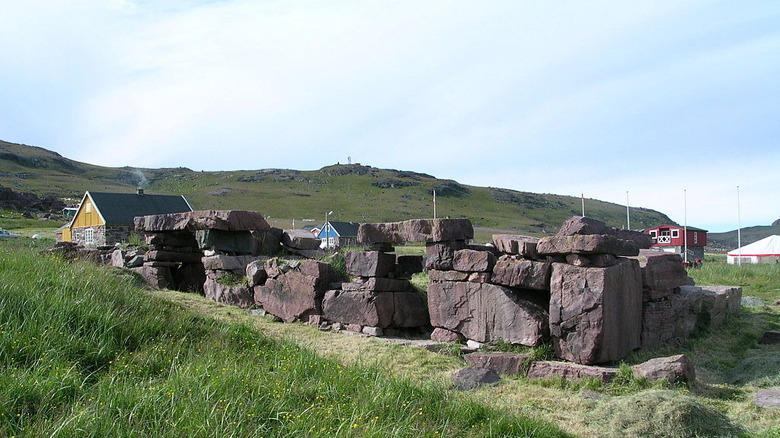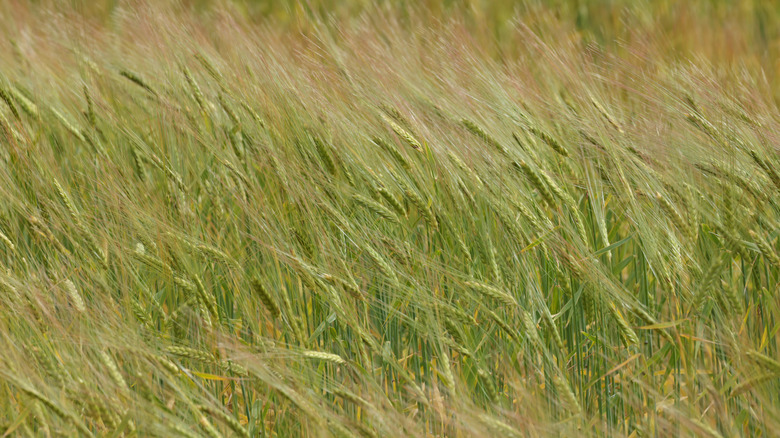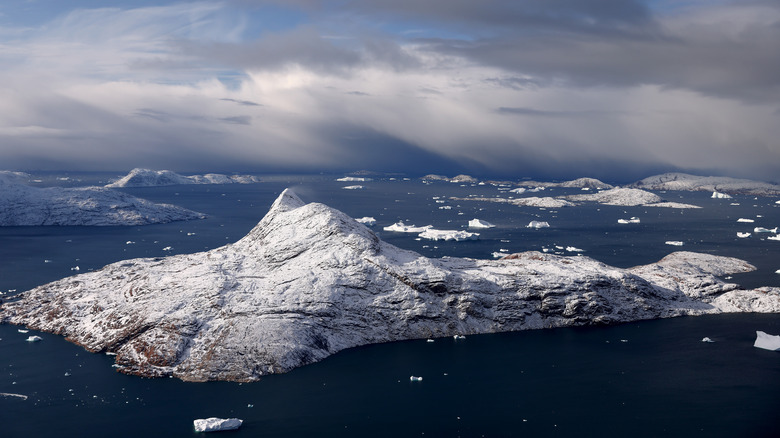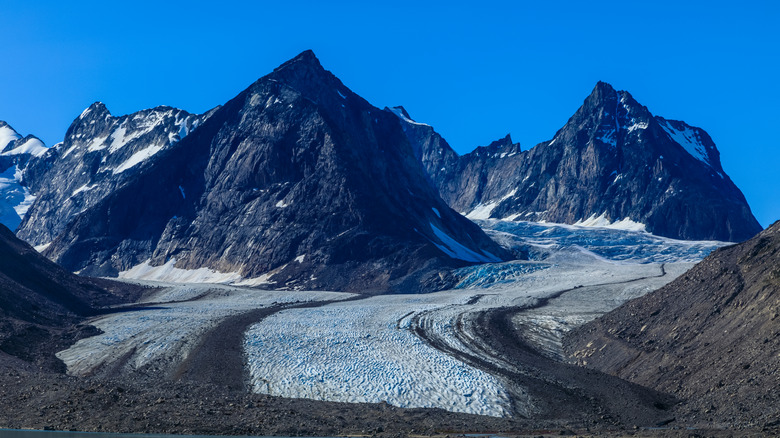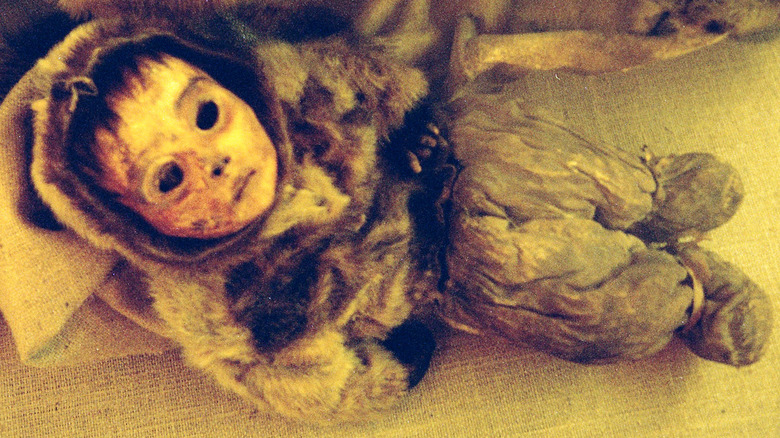The Most Surprising Discoveries In Greenland
The island of Greenland has historically been known as a land steeped in mystery. Covered by a thick ice sheet over a mile thick, the island has not easily given up its secrets. In the face of advancing technologies of the last century, however, archeologists, paleontologists, and geologists have gradually penetrated the ice to uncover Greenland's mysteries. Some of the discoveries have been nothing short of spectacular – and surprising.
Because Greenland is so cold and barren, it is surprising that one could find things such as a medieval cathedral (the first in North America), reptiles, dinosaurs, plants, and even nature's own pyramids. These discoveries have allowed scientists and historians to reconstruct the island's climatological, geological, and social histories from the Triassic Period to the Norse colonies of the Middle Ages. Here are some of the more surprising or interesting things that have been found in Greenland in the last century.
Greenland's Grand Canyon
Officially among the longest canyons in the world, according to NASA, is the Yarlung Tsangpo Canyon in Tibet, reaching a length of ~149 miles. But in reality, this is just the longest visible canyon in the world. According to NPR, however, scientists have recently discovered a massive canyon running through Greenland. The canyon is over twice as long as its Tibetan counterpart, measuring ~466 miles in length, although it is shallower than both the Grand Canyon in Arizona or the one in Tibet.
Most interestingly, scientists from UMass now believe that the Greenland Grand Canyon was formed quickly through several catastrophic events. Greenland's ice sheet has undergone a series of warming periods that have resulted in meltage. Dr. Benjamin Kiesling suggests it is possible that whenever the ice sheet melted, exposed subglacial lakes swelled and burst their banks with water and ice. Thus, these lakes were drained, and their runoff resulted in massive flooding that over time, carved out Greenland's Grand Canyon.
Kiesling and his fellow researchers believe that these massive floods, the result of a melting and expanding ice sheet, would likely have affected global sea levels and oceans. These are not fully understood yet but are important to determine how changes to the ice sheet could impact the globe in the future.
The Hiawatha Crater
According to Science, the Earth experienced a sudden cold snap around 13,000 years ago called the "Younger Dryas." Although the last ice age had just ended, the period saw ice age conditions return to the more northerly parts of the globe. Researchers have struggled to identify the causes of this temperature swing. Among several hypotheses was a 2007 PNAS paper that postulated an extraterrestrial impact in North America. This strike obliterated North American megafauna and sent temperatures tumbling by 8°C (~46°F). The team met criticism, but a discovery several years ago suggests the possibility of a comet or meteor strike may have been correct, even if the effects were exaggerated.
According to the journal Science Advances, researchers discovered a 31km crater under Greenland's Hiawatha Glacier. The impact was dated to the Pleistocene, which according to Britannica, stretches from 2,588,000 years ago to ~11,700 years ago – quite a large range. A separate PNAS study analyzing other ice core samples in Greenland from right before the Younger Dryas suggests, however, that the Hiawatha Crater may be connected to the cooling event. The crater contained large amounts of platinum, as did the ice cores from elsewhere in Greenland. The study concluded that the anomalous levels of platinum could have an extraterrestrial source. The meteorite or other object that struck the Hiawatha Glacier fits this description. So while the question needs further research, the question of the Younger Dryas' origins is one step closer to a solution.
Reptile/amphibian fossils
Greenland hardly seems like the kind of place for amphibians and reptiles to live. After all, cold-blooded animals generally do not do well in freezing polar climates. Yet, as Science Nordic notes, amphibian and reptile fossils have been found all over Greenland hidden beneath the ice. So how is this possible?
210 million years ago, the world looked very different from today. Instead of the seven continents, the world's landmass was agglomerated into a single supercontinent called Pangaea. Greenland, as part of the supercontinent, was located much further south near the equator and was, as expected, much warmer. In fact, according to Danish scientist Jesper Milan, it was a "subtropical paradise," filled with warm lakes, floodplains, and rivers that made ideal breeding and feeding grounds for amphibian and reptile life.
Well after the break-up of Pangaea, the Paleocene-Eocene thermal maximum sent global temperatures spiking as much as 8°C. Thus, as CU Boulder notes, the warmer climate transformed the Arctic (including parts of Greenland) into regions hospitable for reptile and amphibian life. Parts of Greenland resembled the swamps of the Southeastern United States, allowing crocodiles, tortoises, and aquatic turtles to thrive in a very different kind of place than what we see today.
1 million-year-old plant fossils
According to the University of Buffalo, in the 1960s, U.S. researchers drilled one mile below the Greenland Ice Sheet near the old U.S. airbase Camp Century in Greenland's far north. The samples sent to Copenhagen were then basically forgotten until 2019. When American researchers re-accessed them, they found that these samples were full of fossilized plant life. But for plants to thrive in Greenland would have required a smaller or absent ice sheet that would have exposed the ground underneath.
A study published in the journal PNAS noted that the fossils were typical of tundra plants such as brown mosses, along with some plants with woody stems (likely shrubs). As the authors note, these plants could not have survived unless the ice had melted away to expose the ground below it. The Greenland Ice Sheet underwent a series of "interglacial periods" (a.k.a. "warm" periods) in which temperatures spiked above normal and the ice sheet shrank or even disappeared. With the ground exposed, tundra plants would have thrived in this environment, at least until the ice sheet reformed and entombed them for discovery in the 1960s.
The authors of the PNAS study have noted that such information is useful to anticipate future warming scenarios should they come. In such a case, it gives a glimpse into what kind of ecosystems would spring up in polar regions if global temperatures shrank the ice sheet again.
A 500-year-old shark
According to the ReefQuest Center for Shark Research, these cartilaginous predators are rarely found in polar climates, with only eight attested in the Arctic. But one of these species – the Greenland Shark – relishes the cold. These sharks feast on the dead carcasses of whales and narwhals, although they also manage to catch small fish such as salmon. They are generally considered sluggish, as the RQCSR notes that Inuit hunters have been able to drag them out of the water with their bare hands.
But, as it turns out, there is still much to learn. The shark is quite agile and built not for constant speed, but for sudden, quick bursts of acceleration to catch prey. This may have to do with the shark's environment. In the frigid seas of the Arctic, per the NOAA, a slow metabolism (and hence sluggishness) conserves energy, which can be activated when needed. A CBC report even attested that these sharks are capable of swimming up rivers and killing moose as they are drinking.
This fascinating creature, according to Science Nordic, also holds the title of the world's oldest vertebrate. According to Prof. Tobias Wang of the University of Aarhus, one particular specimen was a whopping 512 years old! That, of course, is the upper estimate. The lower end places it at a still-impressive 272 years. But for these animals, 200 years is nothing. After all, as the NOAA notes, these sharks may not even reach sexual maturity until they are around 100 years old.
Arctic sea sponges
According to Scientific American, sea sponges are found in environments with relatively strong ocean currents. Since sponges use filter feeding to capture nutrients, stronger currents bring larger amounts of organic material for them to ingest. Thus, German researchers were surprised to find an ecosystem of sponges living on seemingly-inhospitable extinct volcanoes north of Greenland.
These sponges were special. Biologists from the Max Planck Institute noted that the sediment that the sponges were anchored to was full of fossils of long-dead worms, which had thrived amongst volcanic hydrothermal vents when the volcanoes were still active. More surprising though, was their diet.
According to a study published in Nature, the sponges rely on fossils to survive. The study found that the sponges had formed a symbiotic relationship with bacteria that helped degrade materials such as chitin, the substance that forms the exoskeletons of insects and other arthropods. This relationship allows the sponges to survive and thrive in an environment that at first glance, looks barren and hostile to life.
Issi saaneq
According to Science Alert, paleontologists working in Greenland discovered the island's first dinosaur skeleton way back in 1994. Initially, it was assigned to Plateosaurus, an early species of long-necked herbivores that lived in the Triassic Period. But in 2020-21, Portuguese researchers discovered that it was probably its own species.
In a study published in the journal "Diversity," Victor Beccari and his colleagues in Lisbon reconstructed the dinosaur from the remains of two skulls and concluded that while it was a close relative of the Plateosaurus, it was its own distinct species. The researchers pointed to a battery of anatomical features that were unique to this new dinosaur to justify their conclusions.
According to Martin Luther University, the new dinosaur was named "Issi Saaneq" (cold bones) in tribute to Greenland and the Inuit language spoken there. The dinosaur, which lived approximately 214 million years ago, had its closest relatives in Brazil and Germany. Thus, as Smithsonian Magazine notes, it is possible that it was the result of a migration of sauropodomorphs from South America northwards as the climate became more hospitable to life. Eventually, some of those dinosaurs made their way towards Europe.
The Gardar Cathedral
According to the book "The Viking Discovery of America," Greenland thrived in the Middle Ages. The prosperous eastern settlement contained a whopping 23 churches. According to the Catholic Historical Review, Greenland's Christians eventually became numerous enough to receive a bishop. A bishop needed a cathedral, and so the Gardar Cathedral dedicated to St. Nicholas was built as medieval Greenland's center of Catholic life. According to Atlas Obscura, the church's existence has always been known. It had been the residence of a bishop since 1106, and a titular see with an absentee bishop even after the Greenland colonies were abandoned. The exact location was lost until c. 1920, but once excavators put spade to soil, they found a level of wealth that exceeded expectations.
The ruins were discovered in 1926 and revealed a church that had been expanded several times to include even a bell tower. Around the church was a farm that contained 100 cows and a palatial complex that served as a residence for the bishops of Greenland. The bishops, apart from farming and fishing, also survived by controlling the export of the valuable walrus ivory according to SciTech Daily. When walrus ivory was in great demand, it made the Bishopric of Greenland very rich indeed. Unfortunately, as demand declined and the climate cooled, the settlements were abandoned along with the cathedral, the very first of its type in North America.
Barley
The Norse, according to Science Nordic, were renowned for their love of beer and carousing. Beer is brewed from barley grain (which is also used for bread and oatmeal), so when the Norse settled Greenland, they faced a problem: The island was not conducive to growing barley. How, then, did these intrepid explorers sake their thirst?
As it turns out, the National Museum of Copenhagen (via SN) discovered that the Greenland Norse had barley, as a few grains were discovered in a rubbish heap. However, archeologist Peter Henriksen noted that this was probably not imported barley, as Viking ships were not built to transport large quantities of grain across the North Atlantic. Henriksen argues the barley must have been grown locally at a time when southern Greenland was considerably more green and fertile than it is today.
Thus, the Greenland Norse were able to replicate their Scandinavian lifestyles in their new homes. But it would cost them. According to Smithsonian Magazine, Norse settlement on Greenland had coincided with the Medieval Warm Period, which saw higher temperatures and milder climates even in the northern parts of the globe. But when the Little Ice Age struck in the 13th century, Greenland became increasingly inhospitable. Among the consequences was that the Norse could no longer grow their staple crops, a problem complicated by the Black Death, which killed half of Norway's population – upon whom Greenland depended for many European imports. Although some adapted to a new diet centered around seal hunting, many others left, leaving Greenland to its modern inhabitants – the Inuit.
The world's northernmost 'island'
Greenland has held the title for containing the world's northernmost island, but this is a constantly-shifting title because there is so much about Greenland hidden underneath the ice. So, according to Arctic Today, when a Swiss-Danish expedition attempted to land on what had been then considered the northernmost island, they were surprised to learn that they had discovered a new place for the record.
The expedition was attempting to reach the island of Oodaaq Qeqertaa, which had been recorded as the northernmost island in 1978. They found it and landed on a small island that expedition member Martin Breum described as "less than 30 meters" and consisting of a "stark, unassuming bank of gravel, sea ice, windblown snow patches, yellowish mud and a number of cone-shaped piles of gravel and rock." The expedition planted the Greenlandic flag, and that was that.
A few months later, the expedition requested the coordinates of their landing to confirm that they really had visited Oodaaq Qeqertaa. It turned out they had missed it by 800 meters, and, in fact, it may not even exist anymore. The expedition had instead discovered a new island. According to Breum, these islands are frequently formed on the Greenlandic coast when sea ice pushes rocks and sediment to the surface. Thus, the title for the world's northernmost island will likely always fluctuate as long as there is no rule that the island must be a permanent future of the landscape.
Geikie 'pyramids'
The Geikie Peninsula of Eastern Greenland is not particularly well known, perhaps due to its remoteness and difficulty of access. It is, however, home to one of the most spectacular landscapes in the world. According to NASA, this mountainous region is made up of basalt mountains that emerged during the creation of the Atlantic Ocean after the supercontinent Pangaea broke up.
The basalts of the Geikie Peninsula seem almost too perfect to be a product of nature. As Columbia University notes, the Geikie mountains are shaped like pyramids that consist of smoothly-cut layers of basalt. The mountains' appearance is the result of moving glaciers chipping and chiseling away at the basalts over millions of years, and from far away, the layers and pyramidal shapes of the mountains look almost flawless. Accompanying the pyramids are rows of "toe-like cliffs" that a Columbia observer compared to Egyptian Sphinxes guarding the pyramids. Thus, it is tempting to believe that the Geikie basalts must be man-made. But they are in fact, one of nature's most splendid creations. (Or aliens'.)
Qilakitsoq mummies
According to Atlas Obscura, in 1972, two men that had gone out to hunt grouse came upon eight mummies buried under a pile of stones in an abandoned Inuit village of Qilakitsoq. The frigid cold of Greenland had preserved even their hair. A scientific examination concluded that the mummies were of six women and two male children, including three sisters and an at least 60-year-old woman, who had all died in the mid-15th century. The facial tattoos suggested that all but one of the women were married or had at least gone through puberty.
A study in the Anatomical Record noted that virtually everyone in the party showed health problems. The eldest had cancer, while virtually all of them had lice on and inside their bodies and black lungs from inhaling fumes from oil lamps in sealed quarters. One child had Trisomy-23 (Down's Syndrome).
So how did they die? It is likely that the women succumbed to poor health, and as relatives, were all buried together. The bigger question is the burial of one of the children, whom some observers have suggested was buried alive. According to Dr. Bo Albrechtson (via Visit Greenland) of Greenland's National Museum, this is a possibility. Inuit lore tells that sometimes, orphaned children were buried alive with their mothers, presumably to spare the child a longer, more agonizing death from starvation and neglect. But, it is just that – a possibility. It cannot be said for sure. The mummies, however, in their state of preservation, provide a fascinating snapshot of daily medieval Inuit life in the cold, harsh world that is Greenland.
